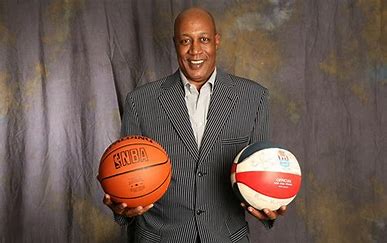
Thirty things to know about George McGinnis, whose No. 30 hangs in the rafters at Gainbridge Fieldhouse. I almost wish he had chosen to wear No. 55 because I could have included many more. But these will do for now.
1 He was not born in Indianapolis as many believe. He was a native of Harpersville, Ala., near Birmingham. His ancestors were sharecroppers, and he had a memory of seeing his mother, Willie, picking cotton. He also remembered her snatching him away from a Whites Only drinking fountain when he was about five years old when they were back in Alabama visiting relatives.
2 He moved to Indianapolis with his parents and older sister, Bonnie, when he was nearly two years old. His father, Burnie, was heading to Chicago to look for a blue collar job that would remove his family from poverty but stopped in Indianapolis to visit his sister. His sister’s husband told him construction workers were being hired downtown, so Burnie stayed over an extra night and looked into it on a Monday morning. He was hired on the spot, so the McGinnis family moved to Indy instead.
The Great Migration of African Americans moving northward to find better employment opportunities was a major factor in Indiana’s basketball history. Hallie Bryant (South Carolina) and Oscar Robertson (Tennessee) were also among those who were born elsewhere but grew up in Indianapolis. I'm sure there were others.
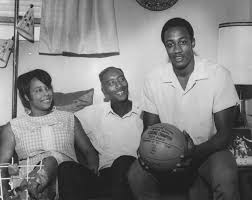
3 He was the star player of one of Indiana’s greatest high school teams, Washington, which went undefeated and won the state championship in 1969. Washington won its regular season games by an average of 35 points, and the only team to come within single digits was city rival Shortridge, which lost by five points. He scored 35 points in the championship game win over Gary Tolleston and set a state scoring record for the final four games of the tournament. All four of the other starters received Division I scholarships – Steve Downing (IU), Louie day (IU for football), Wayne Pack (Tennessee Tech) and Jim Arnold (Texas).
4 He also was an all-American football player as a tight end (22 receptions for 418 yards) and defensive end (77 tackles). He said he had more scholarship offers for football than basketball and thought about playing both sports at IU. The football program was faltering, however, and in the midst of controversy over a boycott by some of the Black players.
The only other sport he played in high school was baseball – which his father had played – but he quit the team during his sophomore year. “I knew I was the best first baseman they had, but (the coach) had this senior on the team and he played in front of me,” he said. “I got pissed off and I quit.”
5 He was an obvious choice for Mr. Basketball, and he had the most dramatic experience of all the state’s players in the all-star series with Kentucky.
He finished with 23 points and 14 rebounds in the first game in Indianapolis but hit just 8-of-26 shots. Afterward a Kentucky player, Joe Voskuhl, said he thought McGinnis was overrated. Motivated by the insult, he came back to score 53 points while hitting 20-of-32 shots and grab 30 rebounds in the second game in Louisville before 17,875 fans in Freedom Hall. He could have scored more but he blew out a shoe in the second half and had to sit out a few minutes while a replacement could be found. He also missed nine foul shots.
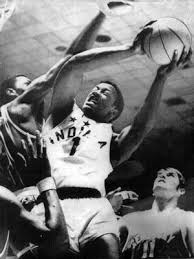
Sometime in the mid-eighties I tracked down Voskuhl, who was a successful businessman in Tulsa. He had a good sense of humor about it. I gave him George’s number and he called George a few times to laugh about the incident. Voskuhl’s son, Jake, played in the NBA.
That was one of the early indications that it wasn’t wise to make McGinnis angry. Although soft-spoken and polite off the court, he had a temper during competition and often used it to his advantage. But it occasionally worked against him as well.
“If someone did something to me and I didn’t get a call … I was a little spoiled that way,” he said. “I would overreact to stuff like that, and people caught on to it, so they started using it against me.”
A primary example of that came in the city championship game for football during his senior season, when he and Cathedral co-captain Dave Weimer were ejected after what a newspaper account called "a mild scuffle." McGinnis thought he had been baited into the confrontation to get him out of the game and Cathedral coach Joe Dezelan admitted "it probably hurt Washington more than it hurt us." Cathedral won the game, handing Washington its only loss of the season.
6 He rode home with his parents after the all-star game in Louisville. His father, Burnie, wasn’t one to offer much praise or affection but Burnie hugged him after the game and talked all the way home about how well he had played. “I knew you were good, but I didn’t know you were that good!” Nine days later, Burnie was killed while helping build an addition to the Eli Lilly headquarters downtown. He fell 60 feet off a scaffolding platform and died shortly after arriving at the hospital. George’s mother was back in Alabama visiting relatives, so George and his sister, Bonnie, were on their own in dealing with the immediate aftermath of it.
7 That tragedy pretty much guaranteed he would turn pro as soon as possible. He played just one season at Indiana University, averaging 30 points and 14.7 rebounds as a sophomore. (Freshman were not eligible for varsity competition then and George was academically ineligible anyway because of his test score, although he was clearly smart enough to get passing grades.) He scored 38 points and grabbed 20 rebounds in his third game as a collegian, against Kentucky, and never looked back, but his dominance caused ripples of jealousy among older players on the team. It collapsed amid controversy late in the season. Coach Lou Watson resigned under pressure from a threatened player boycott, making it that much easier for George to leave.
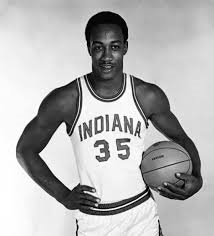
8 Bob Knight, as the world knows, was hired to replace Watson. People often wonder how it would have worked out if he played for Knight. It seems a near certainty that IU would have won the national championship in 1973 if he had stayed two more years. Knight initially made no effort to convince him to stay at IU, considering him, as Downing says, a "renegade." But Knight later said he would have liked to coach him more than any player he ever saw. Most of his IU teammates, however, agree it would not have gone well. He was accustomed to getting his way at that stage of his career and would not have liked Knight’s controlled style of play or screamed critiques.
McGinnis first met Knight after he retired from playing and they became friends. He was invited to accompany IU to the 1987 Final Four in New Orleans and was with the team throughout the weekend, hanging out with Downing, who was IU's assistant athletic director.
“I had the best weekend of my life,” he recalled.
Even in his final years, Knight, when with Downing, would call McGinnis and harass him for not staying to play for him.
“George is the only player (Knight) asks me about – every time,” Downing said. “There’s never been a time I was with him (in recent years) that he doesn’t ask about McGinnis. ‘How’s that f------ McGinnis doing? You tell him if he played for me, he would have made 80 million more dollars because I would have made him play defense.’”
What did that f------ McGinnis think about playing for Knight? “I didn’t like all of his tactics. It would have been hard for me to play for him. But he was one helluva technician.”
9 He says his first contract with the Pacers called for a salary of $37,000 with a $15,000 signing bonus. He used the bonus as a down payment on a house for his mother, who was struggling financially after her husband’s death, although Bonnie was working and lived with her. Seeing his mother’s joy in having a nice house was one of his proudest moments and she lived in it until she passed away in 2019. Although 1,500 square feet, it “was like a mansion to her,” he said.
Meanwhile, he figured he had it made with his first contract. “I thought, man, if I can make this much every year for my entire career I’ll be set!”
10 He joined an established Pacers team that had won the ABA championship in 1970 and had the league's best regular season record in ’71, but he blended in smoothly because of his humble nature. His talent helped, too. He had 29 points and 20 rebounds in his 11th pro game, 26 points and 25 rebounds in his 13th game and 30 points in his 15th.
He suffered a setback in Game 20 when coach Slick Leonard benched him for lack of effort after just 12 minutes. They exchanged words in the locker room afterward, but he came back the next game with 29 points and 15 rebounds in 29 minutes off the bench in a victory at Carolina.
He averaged 16.9 points and 9.7 rebounds in the regular season as a rookie and started most of the games after the first week of January. He averaged 18.3 points and 15.5 rebounds in the six-game series against New York in the finals, when the Pacers won their second title.
11 The Indianapolis Star's beat writer Dave Overpeck dubbed him the "Baby Bull," much to his dismay. Overpeck broke out the nickname, which had been given to previous athletes in other locales, in an Oct. 30 story after the Pacers' victory at Utah in their seventh game of the season when McGinnis came off the bench to score 20 points and grab 14 rebounds.
Overpeck used it routinely the rest of the season and early the following season until McGinnis finally got fed up enough to confront him about it in February. That nickname disappeared from the newspaper after that, but it remains in the conscience of many older fans. “Big Mac” was the most common nickname for him within the fanbase, however. It was an obvious one, and he much preferred it to being compared to a reckless animal.
His nickname within the Pacers organization was “Jif.” Leonard gave it to him. Why? “He said, ‘You’re just so jiffy!’” McGinnis said.
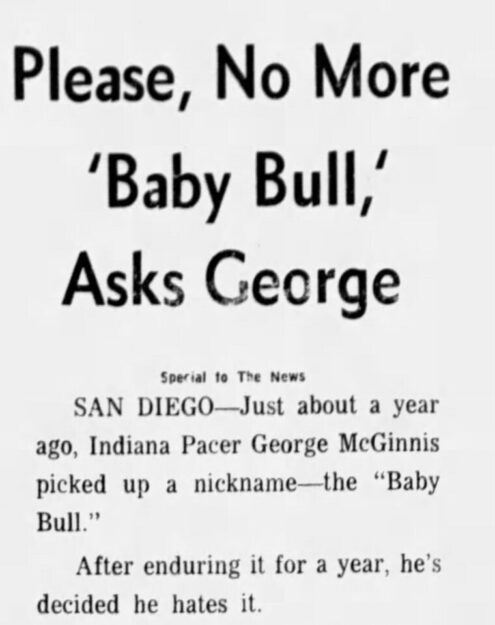
12 He began running off monster games in the 1972-73 season when he first became an all-star. He set the still-standing franchise record of 58 points in an overtime victory at Dallas on Nov. 28, 1972, playing all 53 minutes. He also grabbed 16 rebounds and picked off eight steals in that game. He missed seven foul shots (14-of-21) and had nine turnovers, too, but nobody seemed upset about those faults. Only two of his points came in the overtime period.
Afterward, Leonard declared, “George is about two months away from being the best forward in basketball.” Shown that statement a couple of years before he passed, he found it hilarious that Leonard had it timed so specifically.
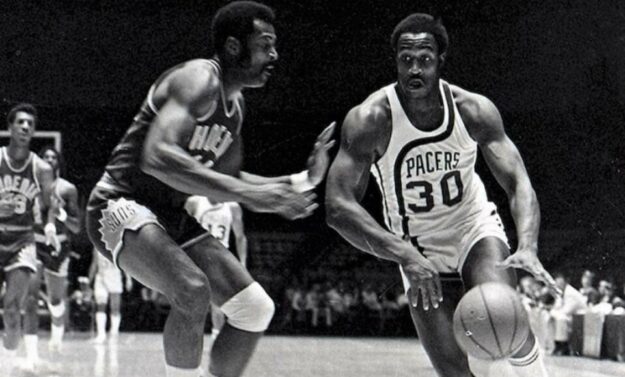
13 He was the MVP of the playoffs when the Pacers won their third title in 1973. He clinched the award in Game 7 in Louisville when he scored 27 points in an 88-81 victory over Kentucky. Thirteen of his points came in the final eight minutes of the third quarter when the Pacers broke open the game.
He was 22 years old. “I think I’ve got a few good years left,” he said, smiling, while smoking a cigar in the postgame locker room.
14 ABA schedules were bizarre at times. In the 1973-74 season, for example, the Pacers played four games in four nights in January, going from Indianapolis to New York to Indianapolis to San Diego. Unfazed, he averaged 35.8 points and 22.8 rebounds over that grueling stretch. He set an ABA record with 37 rebounds in the third game of that series, against Carolina, one that still stands as the Pacers’ individual record. Oh, he had 52 points in that game as well.
It helped that Carolina’s two best forwards, Billy Cunningham and Dennis Wuycik, sat out with injuries and that Pacers center Mel Daniels missed the game and Darnell Hillman was limited by foul trouble. The combination of those factors left more points and rebounds for him to take. He was most pleased with the rebounds, having set a goal in the preseason of setting the league record.
“I really didn’t feel that strong before the game,” he said afterward. “Then things started breaking for me in the first half. Then somebody told me what I had at halftime, and I went out after it in the second half.”
15 Daniels and Freddie Lewis were traded to Memphis following the ’73-74 season, and free agent Roger Brown was not re-signed. Brown then joined Daniels and Lewis in Memphis, along with former Pacer Rick Mount. That left him as the unchallenged centerpiece of a young rebuilding team in the ’74-75 season. He stepped up with the best season of his career – in fact the best individual season in Pacers history – by averaging 29.8 points, 14.3 rebounds, 6.3 assists, 5.3 turnovers and 2.6 steals – all team highs. He led the ABA in scoring, was second in steals, third in assists, fourth in three-point percentage and fifth in rebounding.
His three-point percentage (.354) came as a shock, the result of the confidence gained from having the ultimate green light in the offense. He had hit just 5-of-34 attempts the previous season and never hit better than 25 percent in any other season.
“(Leonard) loosened the reins on me,” he recalled. “Nobody thought we were going to have a big year. We might make the playoffs, or we might not. We got hot and made a helluva run.”
He grew closer to Leonard from that season forward. In Leonard's later years he would call McGinnis on his birthday and sing “Happy Birthday” to him.
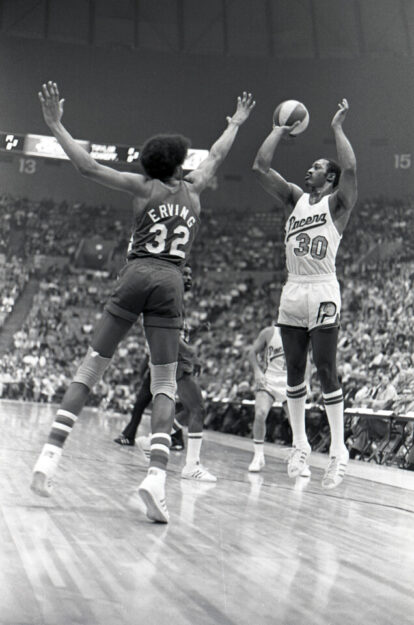
16 The Pacers started slowly that season, as should have been expected with a young team with new faces. Their record was 14-21 after they lost a fifth straight game on Jan. 4, but they finished 45-39 to qualify for the playoffs.
He averaged 32.3 points, 15.9 rebounds and 8.2 assists over 18 postseason games. He had 51 points, 17 rebounds and 10 assists in one game against San Antonio – a one-point homecourt loss. In the decisive Game 7 of the second-round series at Denver, the Nuggets brought out a woman dressed as a witch, named Robota, to put a hex on the Pacers. She was a rebuttal to the Pacers’ importing of Dancing Harry, who put hexes on opposing teams during timeouts. She stood courtside next to a "boiling cauldron" (dry ice, actually) and stared at him throughout pregame warmups, and he admitted years later to being a little spooked by her.
“She wouldn’t look at anybody else, just right at me," he said. "I’d say to Dancing Harry, ‘Get her off me.’ He’d go over there and (put a hex on her by shaking his hands at her).
“She was like a statue. She wouldn’t move. Billy Knight came over and said, ‘Man, I’m sure glad she ain’t staring at me, Jiffo.’”
He got over it quickly, finishing with 40 points, 23 rebounds, eight assists and eight steals in the victory. He was limping because of a foot injury by the end of the final series with Kentucky but still had 31 points, 11 rebounds and nine assists in the Game 5 loss in Louisville that ended the season.
17 He was voted co-MVP of the ABA that season, sharing the honor with New York’s Julius Erving. Each of the 10 ABA cities had three media voters, so 30 votes were distributed. He and Erving each finished with 11 votes. Curiously, to say the least, Denver’s Mack Calvin received six votes and Bobby Jones two. Neither led their team in scoring (Ralph Simpson did) and Jones, a rookie, wasn’t an all-star or Rookie of the Year.
It’s still the only time in the history of the ABA or NBA that the MVP award has been shared. He believed he was penalized for playing in a smaller market than Erving. He didn’t publicly complain about it, but privately made his feelings known.
“He was very, very hurt when he was co-MVP,” Hillman said. “He should have won it that year.”
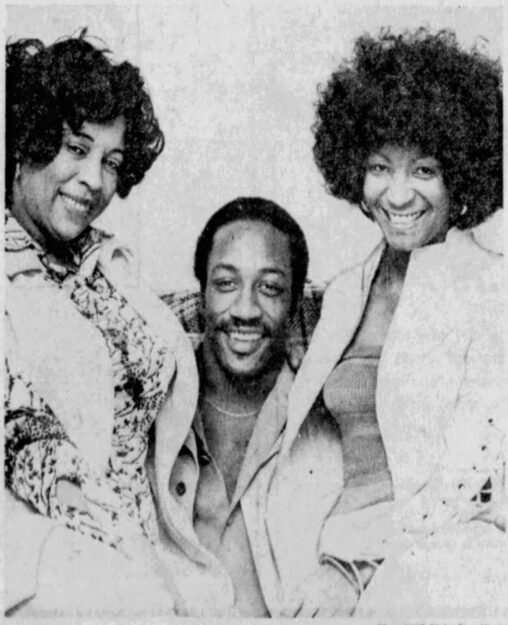
18 He got himself into a bigger market the following summer, but it wasn’t easy. He had signed a two-year contract with the Pacers before his MVP season but had an option on the second season. He took it to become a free agent, paying $85,000 for the privilege. He signed a contract with New York, receiving a $500,000 signing bonus, but Philadelphia owned his NBA rights from having selected him in the second round of the 1973 draft, when he became eligible to play in that league because his college class had graduated.
He had stated publicly he didn’t want to play in Philadelphia but changed his mind after a court ruling against the Knicks. He signed a six-year contract with the 76ers in the neighborhood of $3 million. The Pacers couldn’t come close to matching that kind of offer and Leonard let him go without complaint. Most of the fans seemed to understand as well. When Philadelphia came to Market Square Arena the following fall for an exhibition game he received a standing ovation and only a faint smattering of boos.
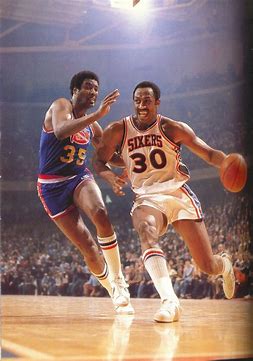
19 He was a national sports figure in Philly. The Sixers put up billboards throughout the city proclaiming, “Let George Do It!” – an old-fashioned expression used when someone wanted to get out of a difficult task. He appeared on the nationally televised Mike Douglas Show and was the focus of media attention in every NBA city. He averaged 23 points, 12.6 rebounds, 4.7 assists and 2.6 steals his first season, earning first-team all-NBA honors. The Sixers’ record improved from 34-48 to 46-36 after his arrival.

20 The following fall, Erving was holding out for a new contract from the New York Nets. Philadelphia general manager Pat Williams convinced his new owner, Fitz Dixon, to ante up and buy the rights to Erving from New York. But first he went to McGinnis after an exhibition game against Washington at Madison Square Garden to get his approval. “If you can do that, sure,” Williams recalled him saying.
It ran the risk of disrupting the developing team chemistry. The 76ers had just finished their preseason with a 7-1 record. Billy Cunningham would retire a couple of days later, but they still had McGinnis and Steve Mix, an all-star in 1975, at forward.
Erving was too good to pass up, though, and McGinnis knew it. That gave the Sixers the two best forwards in the NBA to go with a young, volatile but talented roster that included Daryl Dawkins, World B. Free, Doug Collins, Henry Bibby (Mike's dad), Joe Bryant (Kobe's dad), and Harvey Catchings (Tamika's dad). Erving came off the bench for five games while working his way into shape, and then moved into the starting lineup with McGinnis . They wound up with nearly identical stats, with scoring averages of about 21 points, although Erving had better shooting percentages and McGinnis averaged three more rebounds.
They became good friends and remained so. He asked Erving to be his best man when he married Lynda in Las Vegas over the summer of 1977, but they failed to connect because of travel issues.
21 That 1976-77 team finished 50-32 but lost in the NBA Finals to Portland, an outcome that came to be regarded as the ultimate example of individual losing to a team. The Sixers’ season was filled with jealousies and petty squabbles and his play nosedived during the playoffs. But he re-emerged in Game 6 in Portland, scoring 28 points, grabbing 16 rebounds and picking off four steals. Erving, meanwhile, scored 40 points. All five Portland starters scored in double figures, however, and the Sixers lost by two points when McGinnis missed a leaning shot from about 10 feet in the final seconds.
“We’ve learned a big lesson,” he said afterward. “And the lesson was, ‘there’s no substitute for concentration. There’s no substitute for hard work … all the time.
“We were a team that had a tendency to cut corners because we’re so talented.”
22 He later revealed he had played with a groin pull and had been receiving shots during the playoffs. He also admitted the public criticism – something he had never experienced before – affected him. The following season didn’t go any better. He and Erving still got along and had stat lines similar to the previous season, but he didn’t mesh with Cunningham, Philadelphia’s first-year coach, and the team flamed out in the second round of the playoffs. By then it was obvious he would be traded.
23 There were serious discussions of trading him back to the Pacers for the No. 1 overall draft pick, but it didn’t come off. He was traded to Denver instead, with the other principal in the deal being Bobby Jones. It’s a lesser-known part of his career that he was revitalized with the Nuggets, averaging 22.6 points and 11.4 rebounds. He started for the West in the NBA's all-star game and finished with 16 points and had five steals.
He tore ligaments in his foot when he stepped on the foot of San Diego’s Randy Smith on March 30. He missed the rest of the season and was never the same again.
24 He had a strained relationship with Denver coach Larry Brown. In fact, they clashed on the first day of training camp when Brown didn’t think he was working hard enough. Brown gathered the players in the locker room and told him he wasn’t setting a good example for the younger players. “Then why don’t you trade me?” he replied. Brown tried, immediately calling general manager Carl Scheer.
Brown resigned during the season and Donnie Walsh took over as head coach. He never completely got over his frustration with Brown, whom he considered a “nag” and a back-stabber – a common refrain from those who have played for Brown. But he did express some regrets over how he handled his situation in Denver.
When Brown was in Indianapolis for the Final Four in 1980, coaching a young UCLA team, he said one of the reasons he wanted to leave the NBA for the NCAA was the attitude of some of the NBA players. He cited McGinnis as an example, recalling timeouts when he sat on the scorer’s table and ignored his instructions in the huddle.
25 He returned to play for Walsh the following season, but Walsh engineered the greatest trade in Nuggets history – and perhaps the worst in Pacers’ history - by convincing ownership to trade him for Alex English on Feb. 1, 1980. English went on to have a Hall of Fame career with the Nuggets and was the NBA’s leading scorer for the eighties. McGinnis averaged about 13 points over the next season-and-a-half with the Pacers and then 4.7 points in the 1981-82 season.
He was cut in training camp the following fall. He was given the option of announcing his retirement and going out with a celebration in his honor, but he declined because he thought he could still play. He asked to be put on waivers, hoping to catch on with another team, but nobody called.
“You don’t see your decline,” he said years later.
“It’s not easy to walk away from something you’ve been doing your whole life and boom, all of a sudden it’s over. It took a while to find myself, but I had a good wife.”
26 He and Lynda moved back to Denver for a few years to decompress. He skied in the mountains in Colorado and hunted and fished with friends throughout the West and Alaska. He laughed about the fear some people showed when seeing a large Black man barreling down the slopes, which reminded him of the reaction some people had at Raccoon Lake when he emerged from under the water when skiing there in the seventies.
He was still bitter over being cut by the Pacers when a team representative called a few years later and invited him to return to Indianapolis to have his jersey number retired, along with those of Daniels and Brown. With Lynda acting as an intermediary, he agreed to participate in the ceremony on Nov. 2, 1985. The relationship thawed that weekend and he and Lynda moved back to Indianapolis the following year – for good.
27 He kept busy with a variety of activities for a few years. He was a commentator for high school, college and Pacers broadcasts. He was a representative for the Hoosier Lottery and companies such as Farm Bureau Insurance and served on various boards and committees. “I had more jobs than a Jamaican,” he recalled. Eventually, Lynda nudged him toward starting his own company. GM Supply began operations in 1992 and is still in business.
28 He finally was inducted into the Naismith Hall of Fame in 2017, about 30 years after he became eligible. Rick Barry, who played against him in both the ABA and NBA, was instrumental in making it happen as a voter on the Veteran's Committee. Two years, later, however, he lost both his wife and mother. Although neighbors brought him food and friends checked on him regularly, he was alone in his 4,300 square foot home in Geist. He remained as independent as possible, even doing his own grocery shopping despite needing a walker to get around. He was rarely recognized.
“When I go to the grocery store, nobody says anything,” he said. “It’s pretty cool. I think it’s probably because I’m on a walker and they just see an older person. It used to be I couldn’t walk in anywhere (without being approached by fans). It changes. You’ve got to come back to the real world sometime. The fans will let you know, that’s over.”
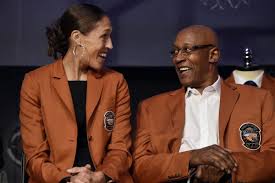
29 The back issues that left him bent over and requiring a walker were not the result of his playing career, but a hereditary affliction. His father suffered back problems before he died in the construction accident and his sister, Bonnie, did as well. He and Bonnie both had major surgeries to insert titanium discs into their spinal columns to be able to stand upright.
He was hesitant because he had nearly died once on the operating table, but Bonnie went first and the surgery worked for her. His also appeared successful for a while but he kept developing infections. Finally, the discs had to be removed. He was bent over again but at least was mostly pain-free. He accepted his fate gracefully, maintaining his upbeat demeanor to the very end despite the difficulty in maneuvering with the walker.
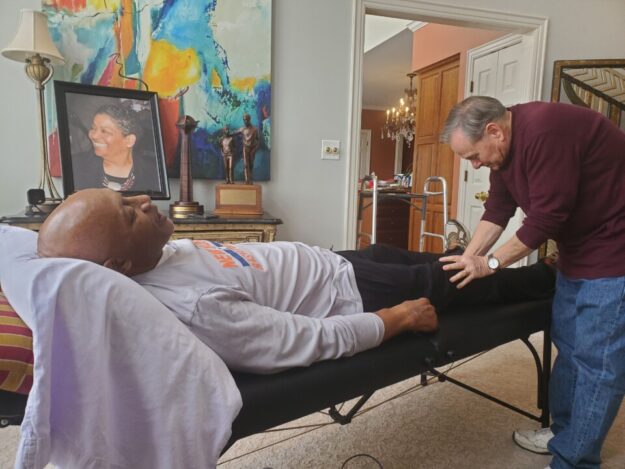
30 He never forgot his roots. He met for lunch with the surviving members of his high school team on the third Thursday of every month, usually at a hole-in-the-wall hamburger place called Workingman’s Friend, over the final few years of his life. He and Downing paid to have new rings made as a memento for their state championship and presented them at a lunch one year.
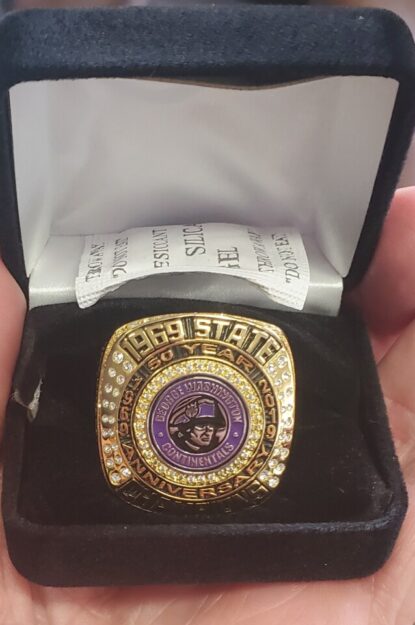
“I used to kid him,” Downing recalled. “I’d say, ‘George, I know you’re going to go away from here someday and forget all about us here back home.’ But he never did.”
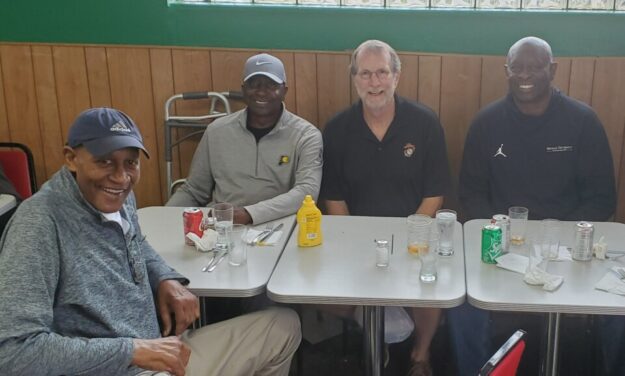


Tagged with: Bob Knight, George McGinnis, Steve Downing
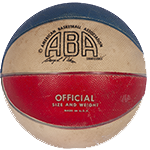 American Basketball Association
American Basketball Association Indiana basketball
Indiana basketball Indiana Mr. Basketball
Indiana Mr. Basketball IU basketball
IU basketball Pacers
Pacers